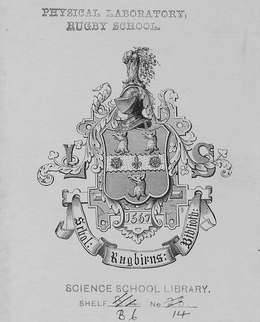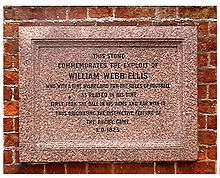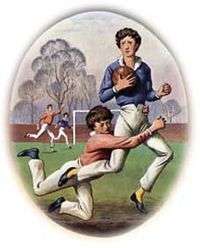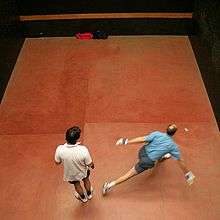Rugby School
Rugby School is an independent co-educational day and boarding school in Rugby, Warwickshire, England. Founded in 1567 as a free grammar school for local boys, it is one of the oldest independent schools in Britain.[1] Up to 1667, the school remained in comparative obscurity. Its re-establishment by Thomas Arnold during his time as Headmaster, from 1828 to 1841, was seen as the forerunner of the Victorian public school.[2] It is one of the original seven Great Nine Public Schools defined by the Clarendon Commission of 1864. Rugby School was also the birthplace of Rugby football.[3] In 1845, a committee of Rugby schoolboys, William Delafield Arnold, W. W. Shirley and Frederick Hutchins,[4] wrote the "Laws of Football as Played At Rugby School", the first published set of laws for any code of football.[5][6]
| Rugby School | |
|---|---|
 | |
| Address | |
Lawrence Sheriff Street , , CV22 5EH England | |
| Coordinates | 52.3675°N 1.2611°W |
| Information | |
| Type | Public school Independent day and boarding school Co-educational school |
| Motto | Latin: Orando Laborando (by praying, by working) |
| Religious affiliation(s) | Church of England |
| Established | 1567 |
| Founder | Lawrence Sheriff |
| Department for Education URN | 125777 Tables |
| Head Master | Peter Green |
| Gender | Co-educational |
| Age | 13 to 18 |
| Enrolment | 810 |
| Houses | 16 |
| Colour(s) | Oxford blue, Cambridge blue, and green |
| Former pupils | Old Rugbeians |
| School song | Floreat Rugbeia |
| Website | www |
As the nature of the school shifted, a new school – Lawrence Sheriff Grammar School – was founded in 1878 to continue Lawrence Sheriff's original intentions. Rugby expanded further in the 20th century and new buildings were built inspired by the Edwardian Era. The Temple Speech Room, named after former headmaster and Archbishop of Canterbury Frederick Temple (1858–69) is now used for whole-School assemblies, speech days, concerts, musicals – and BBC Mastermind. Between the wars, the Memorial Chapel, the Music Schools and a new Sanatorium appeared.
In 1975 two girls were admitted into the sixth form, and the first girls’ house opened 3 years later, followed by three more. In 1992, the first 13-year-old girls arrived, and in 1995 Rugby had its first-ever Head Girl, Louise Woolcock, who appeared on the front page of The Times. In September 2003 a last girls’ house was added. Today, total enrolment of day pupils, from forms 4 to 12, numbers around 800.[7]
History

Early history

Rugby School was founded in 1567 as a provision in the will of Lawrence Sheriff, who had made his fortune supplying groceries to Queen Elizabeth I of England.[8] Since Lawrence Sheriff lived in Rugby and the neighbouring Brownsover, the school was intended to be a free grammar school for the boys of those towns. Up to 1667, the school remained in comparative obscurity. Its history during that trying period is characterised mainly by a series of lawsuits between the Howkins family (descendants of the founder's sister), who tried to defeat the intentions of the testator, and the masters and trustees, who tried to carry them out. A final decision was handed down in 1667, confirming the findings of a commission in favour of the trust, and henceforth the school maintained a steady growth.[9] "Floreat Rugbeia" is the traditional school song.
Academic life
Pupils beginning Rugby in the F Block (first year) study various subjects. In a pupil's second year (E block), they do nine subjects which are for their GCSEs, this is the same for the D Block (GCSE year). The school then provides standard A-levels in 29 subjects. Students at this stage have the choice of taking three or four subjects and are also offered the opportunity to take an extended project.
Scholarships
The Governing Body provides financial benefits with school fees to families unable to afford them. Parents of pupils who are given a Scholarship are capable of obtaining a 10% fee deduction, although more than one scholarship can be awarded to one student.
Growth
It was no longer desirable to have only local boys attending and the nature of the school shifted, and so a new school – Lawrence Sheriff Grammar School – was founded in 1878 to continue Lawrence Sheriff's original intentions; that school receives a substantial proportion of the endowment income from Lawrence Sheriff's estate every year.
The core of the school (which contains School House, featured in Tom Brown's Schooldays) was completed in 1815 and is built around the Old Quad (quadrangle), with its Georgian architecture. Especially notable rooms are the Upper Bench (an intimate space with a book-lined gallery), the Old Hall of School House, and the Old Big School (which makes up one side of the quadrangle and was once the location for teaching all junior pupils). Thomas Hughes (like his fictional hero, Tom Brown) once carved his name on the hands of the school clock, situated on a tower above the Old Quad. The polychromatic school chapel, new quadrangle, Temple Reading Room, Macready Theatre and Gymnasium were designed by well-known Victorian Gothic revival architect William Butterfield in 1875, and the smaller Memorial Chapel was dedicated in 1922.
By the twentieth century Rugby expanded and new buildings were built inspired by this Edwardian Era. The Temple Speech Room, named after former headmaster and Archbishop of Canterbury Frederick Temple (1858–69) and now used for whole-School assemblies, speech days, concerts, musicals – and BBC Mastermind. Oak-panelled walls boast the portraits of illustrious alumni, including Neville Chamberlain holding his piece of paper. Between the wars, the Memorial Chapel, the Music Schools and a new Sanatorium appeared.[10]
Cartel
In 2005, Rugby School was one of fifty of the country's leading independent schools found guilty of running an illegal price-fixing cartel allowing them to drive up fees for thousands of parents.[11] Each school was required to pay a nominal penalty of £10,000 and all agreed to make ex-gratia payments totalling three million pounds into a trust designed to benefit pupils who attended the schools during the period in respect of which fee information was shared.[12] However, Mrs Jean Scott, the head of the Independent Schools Council, said that independent schools had always been exempt from anti-cartel rules applied to business, were following a long-established procedure in sharing the information with each other, and that they were unaware of the change to the law (on which they had not been consulted). She wrote to John Vickers, the OFT director-general, saying, "They are not a group of businessmen meeting behind closed doors to fix the price of their products to the disadvantage of the consumer. They are schools that have quite openly continued to follow a long-established practice because they were unaware that the law had changed."[13]
Head Masters
- Richard Seele – 1600
- Nicolas Greenhill – 1602
- Augustus Rolfe – 1606
- Wiligent Greene – to 1642
- Raphael Pearce – 1642 to 1651
- Peter Whitehead
- John Allen – to 1669
- Knightley Harrison – 1669 to 1674
- Robert Aahbridge – 1674 to 1681
- Leonard Jeacocks – 1681 to 1687
- Henry Holyoake – 1687 to 1730
- John Plomer – 1731 to 1742
- Thomas Crossfield – 1742 to 1744
- William Knail – 1744 to 1751
- John Richmond – 1751 to 1755
- Stanley Burrough – 1755 to 1778
- Thomas James – 1778 to 1794
- Henry Ingles – 1794 to 1806
- John Wooll – 1806 to 1827
- Thomas Arnold – 1828 to 1842
- Archibald Campbell Tait – 1842 to 1848
- Dr Meyrick Goulburn – 1849 to 1857
- Frederick Temple – 1858 to 1869
- Henry Hayman DD – 1870 to 1874
- Thomas William Jex-Blake, DD, 1874 to 1887
- John Percival, DD, – 1887 to 1895
- Herbert Armitage James, DD – 1895 to 1910[14]
- Albert Augustus David – 1910 to 1921[14]
- William Wyamar Vaughan – 1921 to 1931[14]
- Percy Hugh Beverley Lyon – 1931 to 1948[14]
- Sir Arthur Frederic Brownlow fforde – 1948 to 1957[14]
- Walter Hamilton – 1957 to 1966[14]
- James Woodhouse – 1967 to 1980
- Brian Rees −1980 to 1985[15]
- Richard Bull – 1985 to 1990[15]
- Michael Mavor – 1990 to 2001[15]
- Patrick Derham – 2001 to 2014[16]
- Peter Green – 2014–[17]
Thomas Arnold
Rugby's most famous headmaster was Thomas Arnold, appointed in 1828; he executed many reforms to the school curriculum and administration. Arnold's and the school's reputations were immortalised through Thomas Hughes' book Tom Brown's School Days.
David Newsome writes about the new educational methods employed by Arnold in his book, 'Godliness and Good Learning' (Cassell 1961). He calls the morality practised at Arnold's school muscular Christianity. Arnold had three principles: religious and moral principle, gentlemanly conduct and academic performance. Dr George Mosse, former professor of History at the University of Wisconsin-Madison, lectured on Arnold's time at Rugby. According to Mosse, Thomas Arnold created an institution which fused religious and moral principles, gentlemanly conduct, and learning based on self-discipline. These morals were socially enforced through the "Gospel of work." The object of education was to produce "the Christian gentleman," a man with good outward appearance, playful but earnest, industrious, manly, honest, virginal pure, innocent, and responsible.
John Percival
In 1888 the appointment of Marie Bethell Beauclerc by Percival was the first appointment of a female teacher in an English boys' public school and the first time shorthand had been taught in any such school. The shorthand course was popular with one hundred boys in the classes.
Rugby football


The game of Rugby football owes its name to the school. The legend of William Webb Ellis and the origin of the game is commemorated by a plaque. The story that Webb Ellis was the first to pick up a football and run with it, and thus invented a new sport, has been known to be a myth since it was investigated by the Old Rugbeian Society in 1895. There were no standard rules for football in Webb Ellis's time at Rugby (1816–1825) and most varieties involved carrying the ball. The games played at Rugby were organised by the pupils and not the masters, the rules being a matter of custom and not written down. They were frequently changed and modified with each new intake of students. The sole source of the story is Matthew Bloxam, a former pupil but not a contemporary of Webb Ellis. In October 1876, four years after the death of Webb Ellis, in a letter to the school newspaper The Meteor he quotes an unknown friend relating the story to him. He elaborated on the story four years later in another letter to The Meteor, but shed no further light on its source. Richard Lindon, a boot and shoemaker who had premises across the street from the School's main entrance in Lawrence Sheriff Street, is credited with the invention of the "oval" rugby ball, the rubber inflatable bladder and the brass hand pump.[18]
Houses
Rugby School has both day and boarding-pupils, the latter in the majority. Originally it was for boys only, but girls have been admitted to the sixth form since 1975. It went fully co-educational in 1992. The school community is divided into houses.
| House | Founded † | Girls/Boys |
|---|---|---|
| Cotton | 1836[19] | Boys |
| Kilbracken | 1841[20] | Boys |
| Michell | 1882[21] | Boys |
| School Field | 1852[22] | Boys |
| School House | 1750[23] | Boys |
| Sheriff | 1930[24] | Boys |
| Town House | 1567[25] | Boys |
| Whitelaw | 1936[26] | Boys |
| Bradley | 1830 (1992)[27] | Girls |
| Dean | 1832 (1978)[28] | Girls |
| Griffin | 2003[29] | Girls |
| Rupert Brooke | 1860 (1988)[30] | Girls |
| Southfield | 1993[31] | Girls |
| Stanley | 1828 (1992)[32] | Girls |
| Tudor | 1893 (2002)[33] | Girls |
- † Numbers in brackets indicate date of conversion to a Girls' house where applicable
Information

- Age range: 13 – 18
- Day pupils: 77 boys, 64 girls
- Annual boarding fee: £32,025 (GBP)[7]
- Annual day fee: £20,094 (GBP)[7]
- Full boarding pupils: 369 boys, 296 girls
- Termly full boarding fees: £11,357[34]
- Termly day pupil fees: £7,126[34]
- Total pupils: 446 boys, 360 girls
- Including 6th form/FE: 194 boys, 168 girls
- Staff numbers: 100 full-time – 9 part-time
- Method of entry: Common Entrance Exam, interview, scholarship or bursary exam
- Professional affiliations: HMC
- Religious affiliation: Church of England[35]
- Oxbridge acceptance percentage: 10.4% [36]
Former pupils
There have been a number of notable Old Rugbeians including the purported father of the sport of Rugby William Webb Ellis, the inventor of Australian rules football Tom Wills, the war poets Rupert Brooke and John Gillespie Magee, Jr., Prime Minister Neville Chamberlain, author and mathematician Lewis Carroll, poet and cultural critic Matthew Arnold, the author and social critic Salman Rushdie (who said of his time there: "Almost the only thing I am proud of about going to Rugby school was that Lewis Carroll went there too."[37]) and the Irish writer and republican Francis Stuart. The Indian concert pianist, music composer and singer Adnan Sami also studied at Rugby School.[38] Matthew Arnold's father Thomas Arnold, was a headmaster of the school. Philip Henry Bahr (later Sir Philip Henry Manson-Bahr), a zoologist and medical doctor, World War I veteran, was President of both Royal Society of Tropical Medicine and Hygiene and Medical Society of London, and Vice-President of the British Ornithologists’ Union.[39][40] Richard Barrett Talbot Kelly joined the army in 1915, straight after leaving the school, earned a Military Cross during the First World War, and later returned to the school as Director of Art.[41]
See also Category:People educated at Rugby School
Rugbeian Society
The Rugbeian Society is for former pupils at the School.[42] An Old Rugbeian is sometimes referred to as an OR.
The purposes of the society are to encourage and help Rugbeians in interacting with each other and to strengthen the ties between ORs and the school.
In 2010 the Rugbeians reached the semi-finals of the Public Schools' Old Boys' Sevens tournament, hosted by the Old Silhillians to celebrate the 450th anniversary of fellow Warwickshire public school, Solihull School.
Rugby Fives

Rugby Fives is a handball game, similar to squash, played in an enclosed court. It has similarities with Winchester Fives (a form of Wessex Fives) and Eton Fives.
It is most commonly believed to be derived from Wessex Fives, a game played by Thomas Arnold, Headmaster of Rugby, who had played Wessex Fives when a boy at Lord Weymouth's Grammar, now Warminster School. The open court of Wessex Fives, built in 1787, is still in existence at Warminster School although it has fallen out of regular use.
Rugby Fives is played between two players (singles) or between two teams of two players each (doubles), the aim being to hit the ball above a 'bar' across the front wall in such a way that the opposition cannot return it before a second bounce. The ball is slightly larger than a golf ball, leather-coated and hard. Players wear leather padded gloves on both hands, with which they hit the ball.
Rugby Fives continues to have a good following with tournaments being run nationwide, presided over by the Rugby Fives Association.[43]
See also
- List of schools in the West Midlands
- Four Rugby Boys
References
- "Gabbitas". Retrieved 26 August 2015.
- "The truth about Flashman: an old Rugbeian writes". The Daily Telegraph. Retrieved 16 October 2015.
- "Six ways the town of Rugby helped change the world". BBC. Retrieved 29 January 2015
- Curry, Graham (2001). Football: A Study in Diffusion (PDF). Leicester: University of Leicester. p. 28.
- Curry, Graham (2001). Football: A Study in Diffusion (PDF). Leicester: University of Leicester. p. 28.
- – via Wikisource.
- University of Oxford student. "Rugby School". Retrieved 26 August 2015.
- Rugby by Henry Christopher Bradby
- Gilman, D. C.; Peck, H. T.; Colby, F. M., eds. (1905). . New International Encyclopedia (1st ed.). New York: Dodd, Mead.
- rugbyschool.net/history
- "Education – The Times". Retrieved 26 August 2015.
- Article at UK Office of Fair Trade Archived 10 June 2008 at the Wayback Machine
- "Private schools send papers to fee-fixing inquiry". The Daily Telegraph. London. 1 March 2004. Retrieved 15 March 2011.
- John Barclay Hope Simpson, Rugby Since Arnold: A History of Rugby School from 1842, Published by Macmillan, 1967
- "Rugby School – Home". rugbyschool.co.uk.
- "New Post for Head Master". Archived from the original on 24 September 2015. Retrieved 26 August 2015.
- "New Head Master Announced". Archived from the original on 24 September 2015. Retrieved 26 August 2015.
- "richardlindon.com". Archived from the original on 11 March 2007. Retrieved 26 August 2015.
- "Rugby School – Cotton". Retrieved 28 March 2017.
- "Rugby School – Kilbracken". Retrieved 28 March 2017.
- "Walter Gorden Michell Biography". Retrieved 28 March 2017.
- "Rugby – School Field". Retrieved 28 March 2017.
- "Rugby School – School House". Retrieved 28 March 2017.
- "Rugby School – Sheriff". Retrieved 28 March 2017.
- "Rugby School – Town House". Retrieved 28 March 2017.
- "Whitelaw". Retrieved 28 March 2017.
- "Rugby School – Bradley". Retrieved 28 March 2017.
- "The History of Dean House". Retrieved 28 March 2017.
- "The History of Griffin House". Retrieved 28 March 2017.
- "Rugby School – Rupert Brooke". Retrieved 28 March 2017.
- "Rugby School – Southfield (Day)". Retrieved 28 March 2017.
- "Rugby School – Stanley". Retrieved 28 March 2017.
- "Rugby School – Tudor". Retrieved 28 March 2017.
- "Rugby School – Fees". rugbyschool.co.uk.
- "Rugby School". The Good Schools Guide. Retrieved 26 August 2015.
- http://image.guardian.co.uk/sys-files/Education/documents/2007/09/20/100topoxbridge.pdf
- Salman Rushdie: The Arab spring is a demand for desires and rights that are common to all human beings, The Daily Telegraph
- "Adnan Sami". India.com.
- "Sir Philip Henry Manson-Bahr". Lives of the fellows : Munk's Roll : Volume VI. Royal College of Physicians of London. Retrieved 3 December 2014.
- "Obituary Notices: Sir Philip Manson-Bahr, C.M.G., D.S.O., M.A., M.D., F.R.C.P., D.T.M.&H". British Medical Journal. 2 (5525): 1332–1334. 1966. PMC 1944321. PMID 5332525.
- "Lieutenant Richard Talbot Kelly". National Army Museum, London. Retrieved 6 May 2019.
- "Rugby School – (Development Office)". Retrieved 26 August 2015.
- "Ruby Fives Association".
Further reading
- Carter, George David. "The extent to which the novel" Tom Brown's Schooldays",(1857), by Thomas Hughes, accurately reflects the ideas, purposes and policies of Dr. Thomas Arnold in Rugby School, 1828–1842." (MA thesis, Kansas State U, 1967). online
- Hope-Simpson, John Barclay. Rugby Since Arnold: A History of Rugby School from 1842. (1967).
- Mack, Edward Clarence. Public schools and British opinion, 1780 to 1860: An examination of the relationship between contemporary ideas and the evolution of an English institution (1938),comparison with other elite schools
- Neddam*, Fabrice. "Constructing masculinities under Thomas Arnold of Rugby (1828–1842): gender, educational policy and school life in an early‐Victorian public school." Gender and Education 16.3 (2004): 303–326.
- Rouse, W.H.D. A history of Rugby School (1898) online.